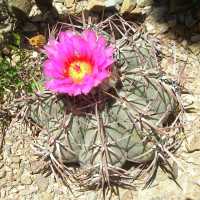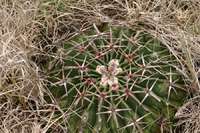Plants erect, branched or unbranched, forming compact mounds of 30+ branches, not deep-seated in substrate (or deep-seated in E. texensis and, if plants immature or at high altitude, in E. horizonthalonius). Roots diffuse or short taproots. Stems unsegmented, gray-blue, gray-green, yellow-green, or grass green, flat-topped spheric to short cylindric, 4-40(-45)[-250] × 8-30[-80] cm, apical region appearing copiously woolly (shortly velvety in E. texensis) [glabrous]; ribs (7-)8-27[-60+], very prominent, straight (or only slightly undulate), sometimes helically curving around stems, broadly rounded to nearly keeled, rib crests uninterrupted or ± constricted between areoles; areoles widely spaced or confluent with age, nearly circular to oblong, with fertile portion as short, broad adaxial prolongation confluent with spine cluster; areolar glands absent; cortex and pith hard, not mucilaginous. Spines (5-)7-19 per areole, straw colored, pink, red, gray, tan, or brown, conspicuously annulate-ridged, rigid, stiff; radial spines 5-14 per areole, straight to curved, 2-5 cm; central spines 1-4 per areole, straight to curved, terete, flattened, or abaxially ridged. Flowers diurnal, near stem apex, near adaxial edges of short adaxial extensions of areoles, broadly funnelform to nearly salverform (more narrowly funnelform in E. texensis); outer tepals margins entire, apically spinose; inner tepals yellow or pink to magenta, 2.4-3.2 × 0.3-1.5 cm, margins entire, serrate, toothed, or erose; ovary scaly, spineless, copiously woolly, with white or pale tan hairs from areoles hiding ovary and flower tube at anthesis; scales 8-60, margins entire or fimbriate, spine-tipped; stigma lobes 6-14(-17), yellow, pink, or olive, 1-4.5 mm. Fruits either indehiscent or rupturing irregularly, or tardily dehiscent through basal abscission pore, whitish tan to pinkish (bright red in E. texensis), spheric to ovoid or ovoid-cylindric, 10-50 × 10-40[-100] mm, usually nearly dry (strongly succulent in E. texensis), many scaled; axils of scales copiously woolly (wool hiding surface of fruits except in E. texensis), spineless, distal scales spine-tipped; pulp red; floral remnant persistent. Seeds reddish brown to black, spheric, or subreniform to obovoid, 2.4-4.7 mm, shiny or dull; testa cells convex or flat. x = 11.
With the exception of the much-branched Echinocactus polycephalus, species of Echinocactus in the flora area are almost never branched, and will die instead of producing a lateral bud when the apex is injured. Smaller than normal fruits of Echinocactus are usually aborted and hollow as the result of infestation by insect larvae (M. Chamberland, pers. comm.).
PLANTS: Barrel cacti, heavily spined, to 2 m tall.
STEM: subglobose, spheric, or cylindric, single or clustering at maturity, to 80 cm in diameter, glabrous; ribs 8-40, straight or occasionally spiraled or undulate.
LEAVES: of long shoot minute or obsolete.
AREOLES: generally circular, in some becoming confluent along the rib, pubescent with white to straw-colored trichomes.
SPINES: terete to flattened, commonly annulate-ridged, inflexible, canescent to glabrous; central spines straight to curved; radial spines smaller, frequently poorly distinguished from centrals.
FLOWERS: diurnal, solitary, apical to subterminal, perfect, actinomorphic, campanulate, 4-7 cm long, 3-8 cm wide; ovary cylindric to globose, floral tube and ovary with lanceolate, linear, or spine-like scales bearing copious white axillary trichomes; outer tepals mucronate; inner tepals petalloid, yellow, pink, reddish, or whitish, numerous, their margins often fimbriate; stamens numerous, exserted, the filaments slender; style and stigma lobes (up to 13) white to yellow or pink.
FRUIT: white to red; scales of floral tube and ovary dry and persistent, with axillary trichomes commonly enveloping and concealing the glabrous fruit epidermis; cylindric to spheric, 1-8 cm long; often dehiscent through a basal pore.
SEEDS: numerous, black to maroon, smooth to wrinkled or papillate, lenticular, 2-3 mm long.
NOTES: 6 spp.; sw U.S. and Mex. (Greek echinos = hedgehog + kaktos = a spiny plant). Chamberland, M. J. 1991. Biosystematics of the Echinocactus polycephalus complex. MS thesis. Arizona State University, Tempe. Unger, Gottfried. 1992. Die groBen Kugelkakteen Nordamerikas. Art-Buchbinderei, Graz, Austria.
REFERENCES: Chamberland, Michael. 1995. Cactaceae Part 2. Echinocacrus. J. Ariz. - Nev. Acad. Sci. 29(1): 13.









